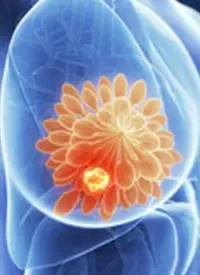News
Article
Atezolizumab Elicits Numerical Improvement in 3-Year EFS, DFS in HER2+ Early Breast Cancer
Author(s):
Key Takeaways
- Atezolizumab addition improved 3-year EFS and DFS rates, especially in PD-L1–negative, HR-positive, or stage T2 disease.
- No increase in pCR rates was observed in the primary analysis.
Atezolizumab plus neoadjuvant
pertuzumab, trastuzumab,
in HER2-positive early breast cancer.

Adding atezolizumab (Tecentriq) to neoadjuvant pertuzumab (Perjeta), trastuzumab (Herceptin), and chemotherapy produced numerically improved 3-year event-free survival (EFS) and disease-free survival (DFS) rates compared with placebo plus pertuzumab, trastuzumab, and chemotherapy in patients with HER2-positive early breast cancer, especially in those with PD-L1–negative, hormone receptor (HR)–positive, or stage T2 disease, according to final results from the phase 3 IMpassion050 trial (NCT03726879).
Outcomes from a 3-year follow-up analysis of the randomized, double-blind trial showed that patients treated on the atezolizumab arm (n = 226) had a 3-year EFS rate of 91.4% compared with 89.0% for those on the placebo arm (n = 228; HR, 0.90; 95% CI, 0.50-1.59). The 3-year DFS rate in patients who had surgery after completion of neoadjuvant therapy was 92.9% in the atezolizumab arm (n = 217) and 88.5% in the placebo arm (n = 217; HR, 0.71; 95% CI, 0.38-1.32).
Furthermore, in patients with PD-L1–positive disease who received atezolizumab vs placebo, the 3-year EFS rates were 90.6% and 93.4%, respectively, while the DFS rates were 91.1% and 92.9%, respectively. Additionally, in the PD-L1–negative population, the 3-year EFS rates were 92.1% and 84.8% and the 3-year DFS rates were 94.6% and 84.1%.
“Although there was no increase in pathological complete response [pCR] rates at the primary analysis, 3-year EFS and DFS rates were numerically improved with atezolizumab, particularly in patients with PD-L1–negative, HR-positive, or stage T2 disease,” lead study author Jens Huober, MD, wrote in a poster presentation of the data. Huober added, “Safety was consistent with the known profiles of pertuzumab [plus] trastuzumab, ado-trastuzumab emtansine [T-DM1; Kadcyla], and atezolizumab.”
Huober is chief physician and director of the Breast Center St. Gallen, as well as a member of the Steering Committee at the Comprehensive Cancer Centre at Cantonal Hospital in St. Gallen, Switzerland.
The primary analysis of IMpassion050 indicated that there was no increase in pCR rates in either the intention-to-treat (ITT) or PD-L1–positive populations of patients with high-risk HER2-positive early breast cancer who received neoadjuvant atezolizumab plus pertuzumab, trastuzumab, and chemotherapy, vs placebo plus pertuzumab, trastuzumab, and chemotherapy.
The present analysis was performed to analyze long-term efficacy and safety results.
The study enrolled patients with HER2-positive early breast cancer who presented with a primary tumor greater than 2 cm and had histologically confirmed positive lymph node status.
These patients were randomly assigned 1:1 to intravenous (IV) atezolizumab 840 mg or placebo plus doxorubicin 60 mg/m2 and cyclophosphamide 600 mg/m2 given every 2 weeks for 4 cycles, followed by IV atezolizumab 1200 mg or placebo with IV pertuzumab (loading dose, 840 mg; maintenance dose, 420 mg) and IV trastuzumab (loading dose, 8 mg/kg; maintenance dose, 6 mg/kg) every 3 weeks for 4 cycles, plus paclitaxel 80 mg/m2 weekly for 12 weeks.
Following neoadjuvant therapy and surgery, patients continued treatment with atezolizumab 1200 mg every 3 weeks or placebo, plus pertuzumab 420 mg every 3 weeks and trastuzumab 6 mg/kg every 3 weeks for up to 1 year. Notably, patients with residual disease could switch to treatment with atezolizumab 1200 mg every 3 weeks, plus T-DM1 3.6 mg/kg every 3 weeks for 14 cycles.
Patients were stratified by stage at diagnosis (T2 vs T3–4), HR status, and PD-L1 status, and were followed for 3 years after enrollment of the last patient. Additionally, analyses of EFS and DFS were performed approximately 36 months after randomization of the last patient.
In addition to the co-primary end points of pCR in the ITT and PD-L1–positive patient populations, secondary end points included EFS, DFS, and safety.
At a data cut-off of August 24, 2023, 90.5% (n = 411) of the overall patient population (n = 454) remained on-study (atezolizumab arm, n = 206/226; placebo arm, n = 205/228). The median follow-up was 44.2 and 43.4 months in the atezolizumab and placebo arms, respectively.
A median of 14 cycles of pertuzumab/trastuzumab was given in both arms.
Regarding safety radiation skin injury (atezolizumab arm, 24.0%; placebo arm, 19.4%), arthralgia (20.7% vs 17.1%), and diarrhea (20.7% vs 13.4%) were the most common overall adverse effects (AEs) observed in 10% or more of patients. AEs of special interest with overlapping toxicities with T-DM1 included immune-mediated pneumonitis (4.1%; 1.4%), immune-mediated hepatitis (diagnosis and laboratory abnormalities [22.1%; 17.1%]), and infusion-related reactions (4.6%; 4.1%).
Notably, there were 24 deaths on the study with 11 occurring on the atezolizumab arm and 13 on the placebo arm; 15 were due to progressive disease, 5 due to AEs, and 4 due to other reasons.
“These results highlight the value of long-term clinical end points when investigating early-stage cancer immunotherapies in HER2-positive breast cancer and support the ongoing ASTEFANIA study [NCT04873362] of adjuvant atezolizumab [plus] T-DM1 in patients with residual disease,” Huober concluded.
Reference
Huober J, Barrios CH, Niikura N, et al. Atezolizumab (A) + pertuzumab + trastuzumab (PH) + chemotherapy (CT) in HER2-positive early breast cancer (HER2+ eBC): final results of the phase III IMpassion050 trial. Ann Oncol. 2024;9(suppl 4):1-25. doi:10.1016/esmoop/esmoop103096








